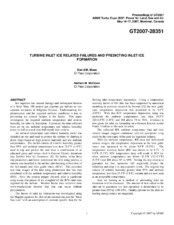| dc.contributor.other | Turbomachinery Symposium (36th : 2007) | |
| dc.creator | Maas, David M. | |
| dc.creator | McCrown, Nathan M. | |
| dc.date.accessioned | 2017-10-04T21:59:10Z | |
| dc.date.available | 2017-10-04T21:59:10Z | |
| dc.date.issued | 2007 | |
| dc.identifier.uri | https://hdl.handle.net/1969.1/163169 | |
| dc.description | ASME Lecture | en |
| dc.description.abstract | Ice ingestion has caused damage and subsequent failures of a Solar Mars 100 natural gas pipeline gas turbine on two separate occasions in Seligman Arizona. Understanding this phenomenon and the required ambient conditions is key to preventing ice related failures in the future. This paper investigates the required ambient temperature and relative humidity for inlet ice formation. It presents the data collected from an on site ambient temperature and relative humidity meter as well as a real time bell-mouth inlet camera. An ambient temperature and relative humidity meter was installed on site and used to protect the turbine by shutting it down (trip) based on high relative humidity and low ambient temperatures. The initial criteria of relative humidity greater then 95% and ambient temperature less then 35.5°F (1.9°C) used to trip and protect the unit were a combination of an educated guess and values cited in General Electric document Gas Turbine Inlet Air Treatment. [1] To further refine these trip parameters and better understand the inlet icing process, a camera was installed in the turbine inlet housing with a view of the bell-mouth and inlet guide vanes (IGV). This provided real time images of the inlet icing phenomena that was then correlated with the ambient temperature and relative humidity (RH). Also, the camera images showed, after a significant icing event, that pieces of ice sloughed off the IGVs and were ingested by the turbine. Weather Radar data collected from www.weather.com shows that this can occur without precipitation. The theory of inlet ice formation was investigated using the Magnus equation for dew-point calculations and the “Ideal Gas Law” with an assumption of constant specific heat for the flowing inlet temperature depression. Using a temperature recovery factor of .8 (this has been supported by numerical modeling in previous research by Stewart [2]) the inlet guide vane temperature depression was predicted to be 6.9°F (3.8°C). With this IGV temperature depression, icing was predicted for ambient temperatures less then 38.9°F (32+6.9°F) (3.8°C) and RH above 74 to 76%. Evidence is also given for inlet ice formation on a General Electric model Frame 3 turbine at the same location. The collected RH, ambient temperature data and inlet camera images suggest condensate and not precipitate icing could be the root cause of the past ice ingestion failures. With the ambient temperature, RH data and bell-mouth camera images, the temperature depression at the inlet guide vanes was measured to be about 9.5°F (5.3°C). The temperature recovery factor (RF) was shown to be 0.73. A 9.5°F (5.3°C) IGV temperature drop will result in IGV ice when ambient temperatures are below 41.5°F (32+9.5°F) (5.3°C) and RH above 67 to 69%. Setting the trip criteria to guarantee ice free operation will negatively impact the reliability and drop it to unacceptable levels. The original trip criteria of relative humidity greater then 95% and ambient temperature less then 35.5°F (1.9°C) remain and are now seen as an acceptable compromise. Inlet air heating as a method of preventing inlet ice formation will be discussed. The amount of heat added to the inlet air to guarantee ice free operation is determined to be greater than 250 hp (186 kW). Finally, options for the inlet air heating energy source are suggested. | en |
| dc.format.medium | Electronic | en |
| dc.format.mimetype | application/pdf | |
| dc.language.iso | en | |
| dc.publisher | Texas A&M University. Turbomachinery Laboratories | |
| dc.relation.ispartof | Proceedings of the 36th Turbomachinery Symposium | en |
| dc.subject.lcsh | Turbomachines | en |
| dc.title | Turbine Inlet Ice Related Failures and Predicting Inlet Ice | en |
| dc.type.genre | Presentation | en |
| dc.type.material | Text | en |
| dc.identifier.doi | https://doi.org/10.21423/R13W86 | |


